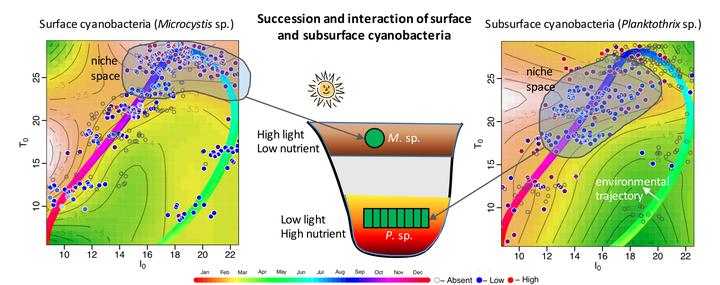Succession and interaction of surface and subsurface cyanobacterial blooms in oligotrophic/mesotrophic reservoirs: a case study in Miyun Reservoir
 Graphic Abstract
Graphic Abstract
Abstract
Subsurface cyanobacterial blooms, are a significant source of odor problems in source water and have been recorded in many oligotrophic/mesotrophic drinking water reservoirs. In this study, we explored the key driving forces responsible for the succession between surface and subsurface cyanobacteria using ecological niche modelling based upon a case study in Miyun Reservoir, China. The results suggest a negative effect of water depth and surface light irradiance (I₀) on subsurface Planktothrix sp. growth (p-values < 0.001), and a unimodal effect of surface water temperature (T₀) with the optimum at 23 ℃ (p-value < 0.001). While the surface Microcystis spp. shows a strong positive relationship with temperature (T₀; p-value < 0.001), and significant effects for the interaction between T₀ and I₀ (p-value < 0.01). In addition, we identified the extent and type of interaction between subsurface and surface cyanobacteria and conclude that the high irradiance surface water combined with sufficient nutrients at the pre-bloom stage are key factors responsible for the preferential growth of surface cyanobacteria, while the gradual decline of the surface cyanobacteria in post-bloom stage is associate with nutrient reduction. This decline and loss of surface populations enhanced underwater irradiance and thus promoted the growth and allowed for succession of subsurface cyanobacteria in deeper layers where the nutrient supply was still adequate. Based upon this, the growth potentials for the subsurface and surface cyanobacteria are different under different environmental conditions: the subsurface cyanobacteria have greater growth potential than surface cyanobacteria in shallow oligotrophic and deep eutrophic reservoirs during median light irrigation seasons.
Highlights
- High light and nutrient at pre-bloom stage are essential for surface cyanobacteria.
- Surface cell decline enhanced underwater light thus promoted subsurface cyanobacteria.
- Subsurface cyanobacteria prefer to grow in shallow oligotrophic/deep eutrophic water.